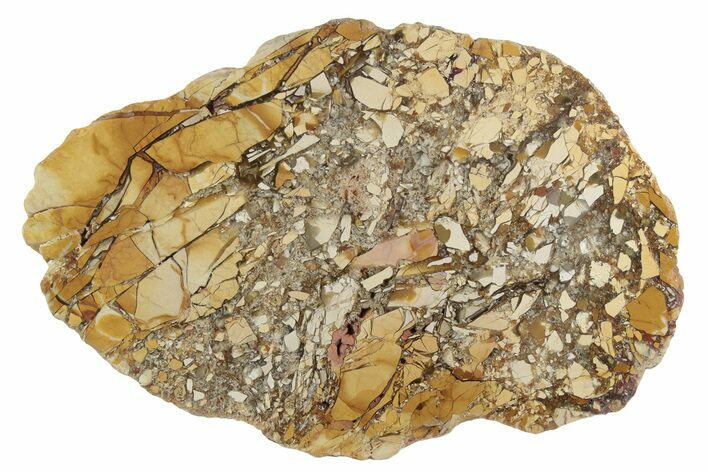This Specimen has been sold.
10.5" Polished, Brecciated Mookaite Slab - Western Australia
This is a 10.5" wide, polished slab of brecciated mookaite. One side has been cut flat and polished to a glossy finish. This material would have come from an area in the mookaite jasper deposit that experience significant disturbance, likely tectonic in nature. Following the natural fragmentation of this rock, ground water containing silica assisted in the natural cementing process of the fragmented mookaite, resulting in this beautiful breccia.
It comes with an acrylic display stand.
It comes with an acrylic display stand.
About Mookaite Jasper
Mookaite jasper is a stunning, multi-colored stone with vibrant hues of reds, yellow and purples, formed from the fossilized remains of microscopic radiolarians. It is found in the 110 million-year-old Windalia Radiolarite formation, which formed on a shallow, marine shelf. Mookaite is found as vibrantly colored nodules in certain beds of soft white clay within the formation.
Radiolarite is a fine-grained, chert-like sedimentary rock composed predominantly of the microscopic remains of radiolarians. Radiolaria are tiny (100 micrometers!), free-floating, zooplankton that produce intricate mineral skeletons made of silica. When the radiolarians died, their tiny silica based skeletons settled on the bottom of the ocean and became covered in sediments like mud and clay.
As this sediment turned to sedimentary rock in a process known as diagenesis, the silica from the radiolarian skeletons pinched and coagulated into ribbons, nodules and other irregular concretions. These ribbons, nodules, and concretions are the mookaite within the clay layers. The coloration is due to other (mostly iron based) mineral impurities present along with the silica. Thus, mookaite can be considered as a fossiliferous sedimentary rock made out of the tiny skeletons of radiolarians.
Mookaite jasper is a stunning, multi-colored stone with vibrant hues of reds, yellow and purples, formed from the fossilized remains of microscopic radiolarians. It is found in the 110 million-year-old Windalia Radiolarite formation, which formed on a shallow, marine shelf. Mookaite is found as vibrantly colored nodules in certain beds of soft white clay within the formation.
Radiolarite is a fine-grained, chert-like sedimentary rock composed predominantly of the microscopic remains of radiolarians. Radiolaria are tiny (100 micrometers!), free-floating, zooplankton that produce intricate mineral skeletons made of silica. When the radiolarians died, their tiny silica based skeletons settled on the bottom of the ocean and became covered in sediments like mud and clay.
As this sediment turned to sedimentary rock in a process known as diagenesis, the silica from the radiolarian skeletons pinched and coagulated into ribbons, nodules and other irregular concretions. These ribbons, nodules, and concretions are the mookaite within the clay layers. The coloration is due to other (mostly iron based) mineral impurities present along with the silica. Thus, mookaite can be considered as a fossiliferous sedimentary rock made out of the tiny skeletons of radiolarians.
SPECIES
Chalcedony var. Jasper
LOCATION
Mooka Creek, Gascoyne Junction, Western Australia
FORMATION
Windalia Radiolarite
SIZE
10.5 x 6.9", .35" thick
CATEGORY
SUB CATEGORY
ITEM
#240117
 Reviews
Reviews












